
Updated On: September 24, 2024
You must have heard contextual backlinks are the most valuable type of links for SEO. That’s why you’re here, looking to learn more about contextual links, their benefits, and how to gain them.
Contextual backlinks are hyperlinks embedded within relevant content.
I’ll gladly provide you with all the answers based on my own experience and the insights from other SEO experts.
TL;DR
Contextual backlinks are hyperlinks embedded within the relevant content of another webpage. These links naturally fit into the context of the surrounding content and usually provide additional information or resources related to the topic being discussed.
There are three types of contextual backlinks based on the relationship between the linking site and the page linked:
Let’s look into each.
These are links that connect different pages within the same website.

This is an internal contextual link pointing from one page of the Influencer Marketing Hub blog to another page within the same blog.
For example, if your blog post mentions a related topic that was covered in a previous article on your website, you should interlink these pages. It will not only help users navigate a website more easily but also improve the overall structure and organization of the site for search engines.
These links come from external websites to your website's pages.
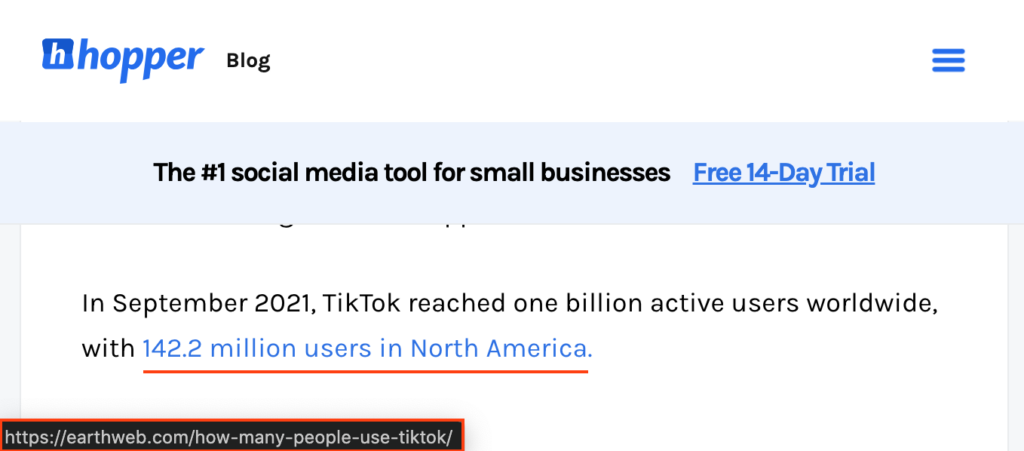
For EarthWeb, this is an inbound contextual link.
Inbound contextual links are the most important from the SEO perspective — they signal to search engines that your content is trustworthy and authoritative within its topic area.
Also known as external links, these links point from your website's pages to external websites.

While in this example, Semrush links to their own resource, the link points out to an external channel, which makes it technically an outbound backlink.
Outbound contextual links provide additional resources or references on the topic. While they may potentially divert traffic away from your site, you shouldn’t worry about it. If they find your site valuable, they’ll come back. If not, they’ll leave it anyway.
If you’re not convinced, just insert the target=”_blank” attribute to make outbound links open in a new tab.
What makes contextual backlinks worth the effort? It’s all the positive outcomes, namely:
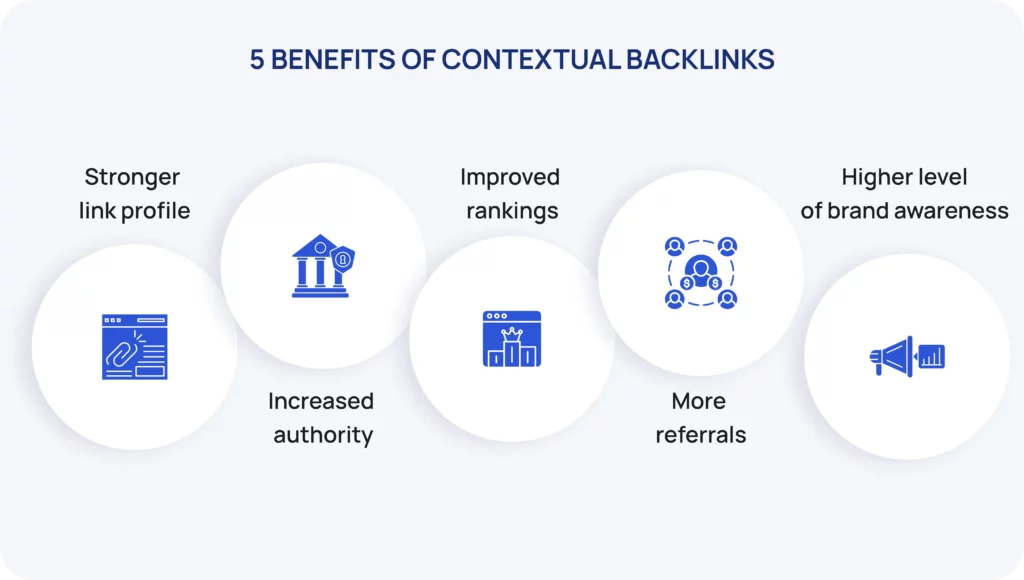
Contextual backlinks are extremely beneficial to your link profile because search engines like Google see them as more natural and useful.
By incorporating all three types of contextual links (internal, outbound, and inbound) into your strategy, you’ll build a healthy-looking link profile that emphasizes your site’s credibility in the eyes of search engines.
This is where inbound contextual links shine in particular. When you earn a backlink from a trustworthy, topically relevant site, it passes a portion of its authority, also known as "link juice," to your site. This process is fundamental in how search engines determine the credibility and relevance of web pages.
Generally, the more authoritative the sites you earn links from, the fewer links you need to achieve your goals.
💡Tip: Don’t confuse the concept of authority with third-party metrics such as domain authority (DA), domain rating (DR), and others. These metrics are only useful for estimating the likelihood that a site is perceived as trustworthy by search engines, based on the quality and quantity of its external backlinks.
Check out our guide on authority backlinks to better understand how the concept of authority operates in SEO.
Building a strong link profile or boosting your site’s authority is hardly the main reason you’ve invested in link building. One of your primary goals is to improve the rankings of certain pages or the whole site.
With contextual links, you’ll achieve this goal and sustain it over time.
Nathan Gotch, Founder of Gotch SEO Academy, emphasizes the importance of contextual linking and warns SEO experts about the consequences of evaluating link-building opportunities on DR alone. Gotch demonstrates the stark decline in traffic experienced by a high DR website that was penalized by Google for engaging in manipulative practices. It doesn’t take a genius to figure out that other websites that received links from this penalized site would also experience negative consequences, including a decline in rankings.
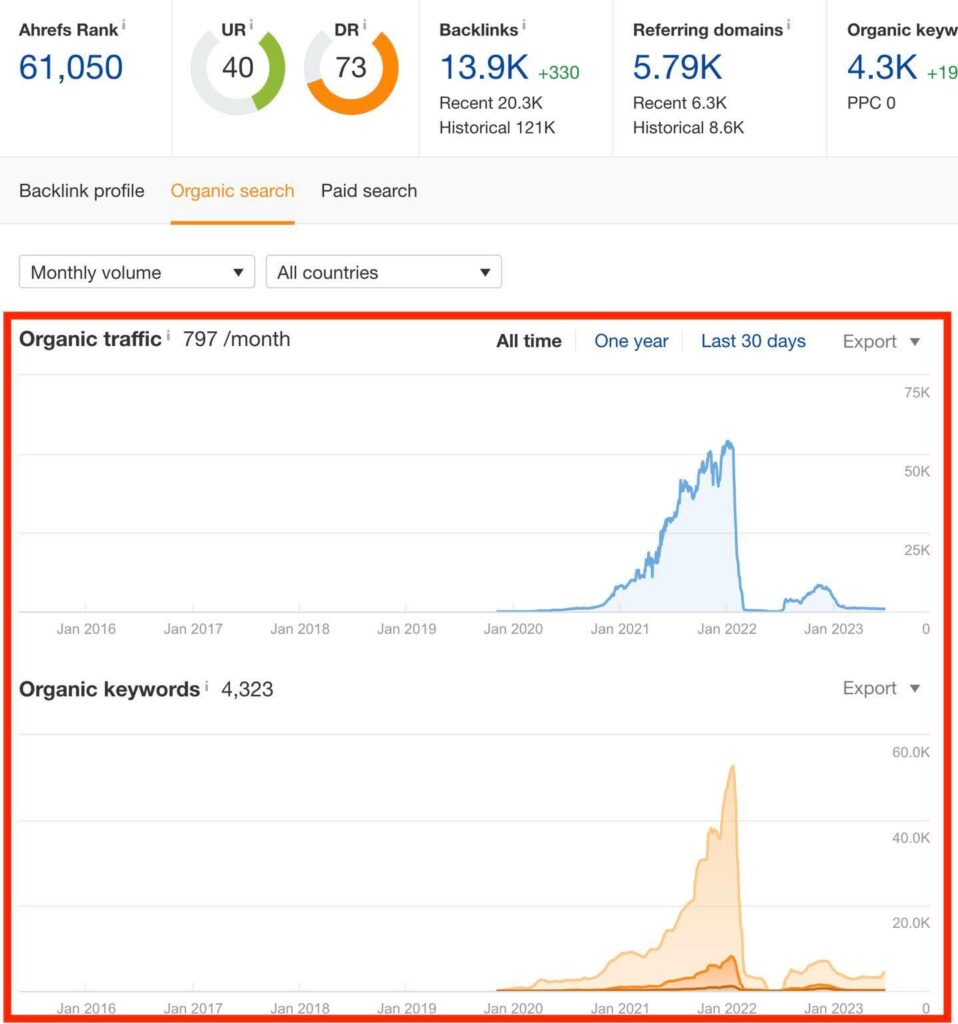
By prioritizing link relevancy over quick wins, you're more likely to achieve long-lasting positive outcomes and maintain stable rankings.
A lot of SEO blogs emphasize increased referral traffic as one of the main benefits of contextual backlinks. I bet those articles were written by people who have never tried to drive referral traffic through link building.
The truth is, while contextual links may drive some clicks, the number is usually too insignificant to have a substantial impact on overall site traffic. There are exclusions though:
Otherwise, I wouldn’t expect contextual backlinks to drive significant referral traffic on their own.
When a high-authority site links to an external source, people naturally perceive the linked source as trustworthy — assuming people actually click the link. If you want to boost brand awareness through link building, think about the types of content and anchor texts that attract readers’ attention. For instance, when citing research, authors usually include the name of the company that conducted it, which leads to increased visibility and recognition for the brand.
Let’s break down the criteria that define a contextual link that carries significant weight for your ink profile.
Link relevance stands out as one of the factors for determining the rankings of the page linked. It’s basically an indicator of how the topic of page A is related to page B if one links to the other. The more relevant the link, the more likely both pages are to rank for queries related to their topic.
Search engines determine link relevance by:
So how do you find contextually relevant pages for link building? Simply researching the relevant topic(s) isn’t very productive — the results will most likely be dominated by your competitors (and it doesn’t look like they’re willing to link back to your site, does it?).
Antonio Gabric, Outreach Manager at Hunter, suggests a neat workaround — that is using the AROUND(X) search operator to find all articles that touch upon your selected topic. The search operator defines the maximum distance between the two keywords, thus helping you identify potential variations of anchor texts and access a wider selection of relevant content.
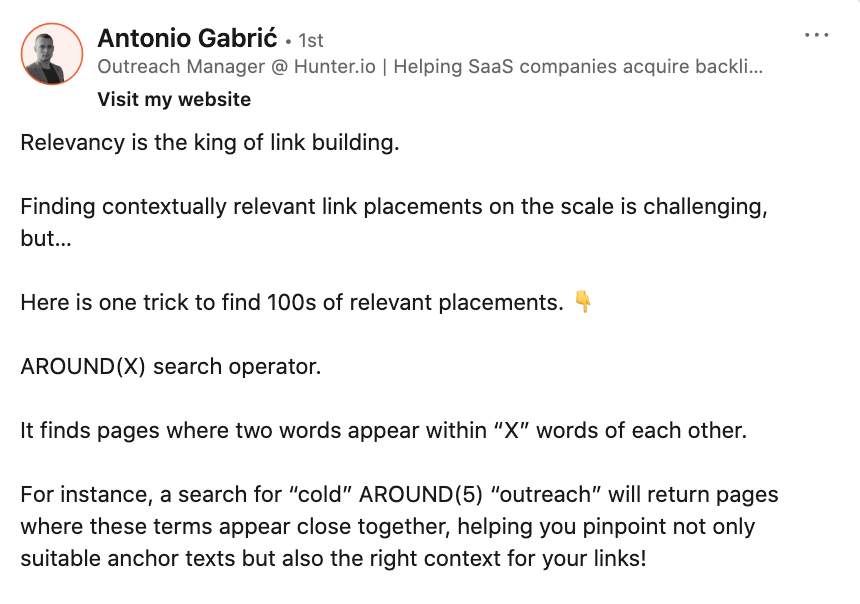
The anchor text used in the backlink provides additional context to search engines about the content of your page, helping to rank it for the right keywords.
When choosing an anchor text for your link (given that you have control over it), pick the keywords that most accurately describe the page or idea you're linking to.
💡Tip: While it's essential to optimize anchor texts for relevant keywords, avoid over-optimization by stuffing them with too many keywords or using exact-match anchor texts repeatedly.
To make the most of contextual linking, you need three things: quality content, a solid internal linking structure, and an effective manual link-building strategy.
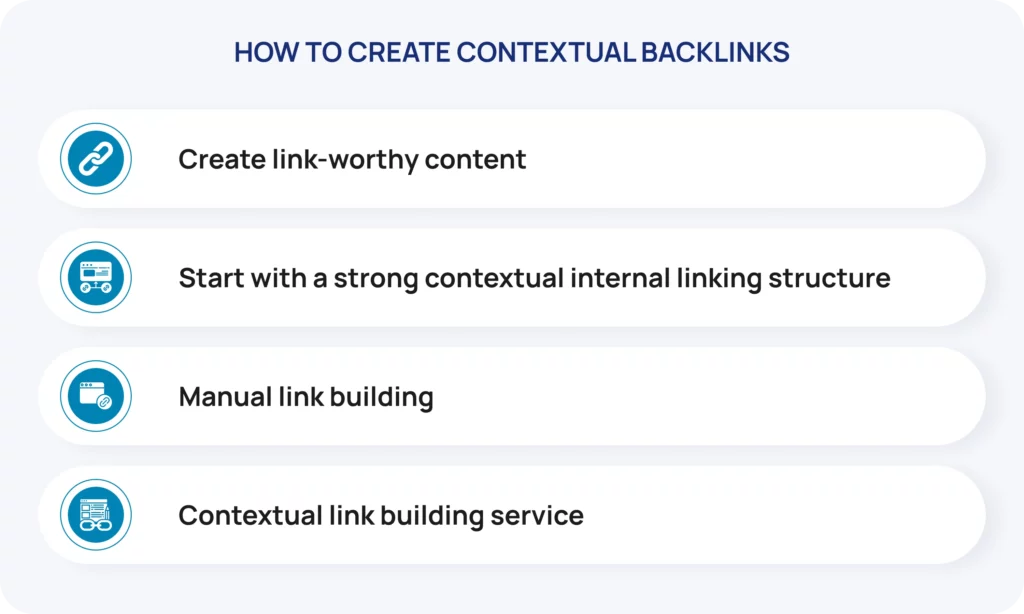
To spend less time on link building while enjoying exponential link profile growth, double down on content that has the potential to attract links naturally.
Here are a few examples of content formats journalists and alike can’t resist:
Step two: let's get our own house in order. Interlink the key pages of your site to make it easier for search engines to crawl and index your pages and distribute link equity throughout your site.
Begin by mapping out the hierarchy of your website, including the main categories and subcategories. Determine which pages are most important for your website. These could be cornerstone content, product pages, service pages, or any other pages that you want to prioritize. These key pages will serve as the foundation for your internal linking strategy.
When linking between your own pages, use descriptive anchor text that accurately describes the linked page's content. Avoid generic phrases like "click here" and instead use keywords that provide context to both users and search engines.
As soon as you’ve created link-worthy content and optimized the internal linking structure, you can start driving contextual inbound backlinks to your site. Easier said than done, huh?
There’s no alternative to manual link building to gain high-quality contextual links. Get ready to spend the next few months on research, outreach, and content creation until you see the first tangible outcomes.
Where do you start? If you simply begin reaching out to editors out of the blue and ask them to insert your links, the success rate will be incredibly low. As a site owner and regular contributor on other sites, I often receive requests like the one in the screenshot. Guess how many of them get answered? Exactly.

To help you quickly get up to speed, I've selected the eight best manual link-building strategies that are effective for everyone:
Whatever strategy you select, always remember the key criteria of a quality placement:
Link builder or agency doesn’t see beyond DR = a huge red flag. 🚩
Here is what’s more important than high DR:
→ Anchor texts
→ Top ranking pages
→ Website growth over time
→ Backlink profile relevancy
→ Content quality and relevancy
→ Incoming/outgoing backlinks ratio
If building your contextual backlinks feels like trying to build a rocket from scratch, there’s always an easier alternative. You don’t have to go solo because there are agencies out there offering a contextual link-building service — which basically means they’ll handle the whole process for you.
But how do you pick the right team to trust with your backlinks?
Here’s what you want to check:
Go beyond what’s on their website. Dig into reviews on unbiased platforms. Are people happy with their work, or are they just good at selling promises?
If they can’t show you proof of results, that’s a red flag. Look for success stories that should speak louder than any sales pitch.
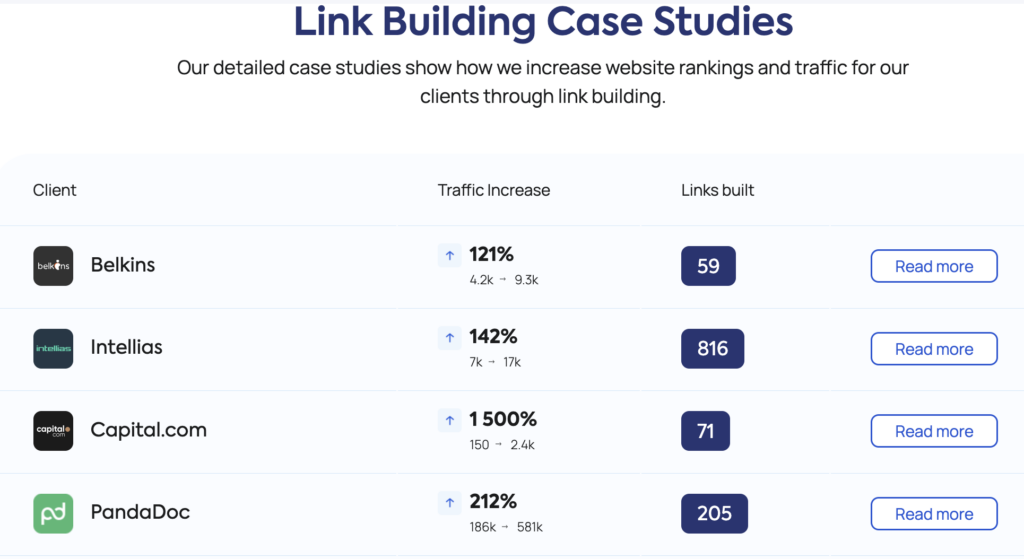
Ask upfront about their process. Are they going the white-hat route when building those working links for you, or are they buying them and risking your site's reputation? You want legit methods here.
It's always nice if they give you a chance to test their service before locking you into anything. A trial link can show you if they're worth it without making you commit.
Check if they offer a money-back option. If the links they build aren’t what you expected, you don’t want to be stuck paying for subpar results.
Some companies will also let you approve the sites where your links will be placed before moving forward. That way, you’ll know the links are going to quality places, not random ones.
So pay attention to these details and you’ll find an agency that doesn’t just talk the talk but walks the walk when delivering solid, contextual backlinks.
Sure, you can buy contextual backlinks — but do we recommend it? No.
Buying links can (and most definitely will) get you in trouble with Google. After all, their algorithms are pretty sharp, and paid links can lead to penalties (not to mention it’s not exactly the most ethical route).
Still, plenty of backlink resellers are out there, offering cheap deals like $50 for a so-called “contextual backlink.” Take Fiverr for example.

But ask yourself, can a quality link really cost $50?
We’re skeptical.
Based on our research, the price of a good, mid-range link is usually between $300 and $600. Cheap links often come from shady sites that do more harm than good.
Cheap links might look like a good deal, but taking shortcuts here can cause more problems than they solve. Quality backlinks require more investment, and trying to go the cheap route often leads to failure.
While building contextual links manually demands a lot of time and effort, the results definitely justify the investment. If you're lacking the resources to kickstart and expand your contextual link-building efforts, Editorial.Link is here to assist you.
Our team of top link-building experts will discuss your goals with you and help you win high DR contextual links that bring you closer to those goals. We focus on relationship-based link building, no shady schemes or manipulative practices. Contact us to get a free sample of links.